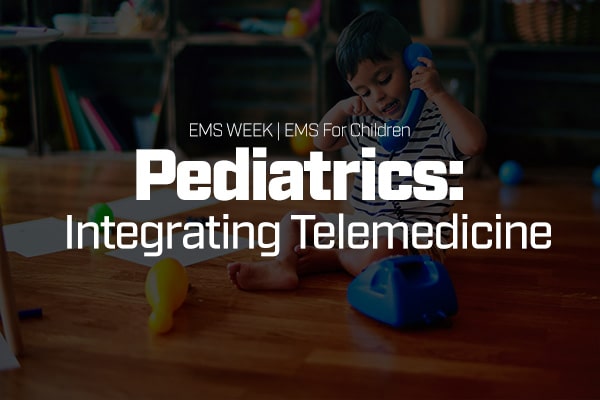Pediatrics: Integrating Telemedicine

Pediatric pre-hospital and critical care transport medicine is undergoing a revolutionary change due to the ongoing evolution and expansion of telemedicine. This trending topic is currently reshaping the nature of patient care, enabling healthcare professionals to provide quality care regardless of the distance between them and the child in need.
Telemedicine in Pediatric Care
Telemedicine involves the use of electronic information and telecommunications technologies to support long-distance healthcare services. In recent years, it has increasingly been adopted in various medical disciplines (Hollander & Carr, 2020). This transformative approach to healthcare can be particularly beneficial in pediatric care, where transport logistics can pose serious challenges.
Benefits of Telemedicine
The implementation of telemedicine can increase access to specialized pediatric services, especially in rural and underserved areas (Marcin, Ellis, Mawis, Nagrampa, Nesbitt, & Dimand, 2004). It can also reduce the need for inter-facility transfers, which are often stressful and potentially risky for pediatric patients (Ray, Dayan, Pahalyants, & Chernick, 2018).
Telemedicine also allows for rapid consultation with specialists, potentially improving patient outcomes (Siew, Hsia, Abir, & Menchine, 2019). Additionally, it can enhance communication between the medical team, patients, and their families, leading to increased satisfaction and understanding of the child’s condition (Fiks, DuRivage, Mayne, Finch, Ross, Giacomini, & Suh, 2016).
Telemedicine in Pre-Hospital and Critical Care Transport Medicine
In the context of pre-hospital and critical care transport medicine, the use of telemedicine can enable real-time communication between the transport team and hospital-based specialists. This offers several significant advantages.
Improved Medical Decision Making
Medical teams can discuss the patient’s condition, share vital signs and images, and make critical decisions collaboratively. This integration of information may enhance the quality of care provided during transportation (Lowthian et al., 2020). It also shares the burden of decision-making related to care in these younger populations. As providers we often find ourselves applying adult knowledge to “not adults.”
“Success is not about taking shortcuts or cowboying it. It’s about having the discipline and integrity to do things the right way, even when no one is watching.”
– Every Mentor I Ever Had. Seriously. All of them.
Be successful and improve patient outcomes with your pediatrics by collaborating and communicating with the patient’s entire team. It’s ok to ask. It’s not ok to not ask and make a mistake that endangers your patient only to find out that you could have been more successful just by making a call.
Increased Safety and Efficiency
Telemedicine could help reduce the time to treatment, which is particularly vital in emergency pediatric situations where every minute counts. By supporting immediate intervention, telemedicine could mitigate the risk of further complications (Rogove, McArthur, Demaerschalk, & Vespa, 2012).
Telemedicine Platforms
One of the most innovative telemedicine platforms that pre-hospital providers might use to improve pediatric care is Pulsara. Pulsara is a real-time, HIPAA-compliant communication platform that is designed to enhance the efficiency of emergency medical services.
One key feature of Pulsara is its ability to streamline communication among all team members involved in a patient’s care. It allows for instant team activation, real-time patient updates, and critical data sharing. This is particularly useful when treating pediatric patients, where rapid response and accurate information are crucial.
Moreover, Pulsara is device agnostic, meaning it works on any device (smartphones, tablets, computers) with an internet connection, allowing providers to use it in various settings including pre-hospital environments.
Conclusion
The ongoing trend of integrating telemedicine into pediatric pre-hospital and critical care transport medicine offers exciting possibilities for improved care delivery. As the technology continues to evolve, further advancements are expected in this field. Healthcare providers must adapt and adopt these technologies to better serve their pediatric patients and improve overall outcomes.
References
- Fiks, A. G., DuRivage, N., Mayne, S., Finch, S., Ross, M. E., Giacomini, K., & Suh, A. (2016). Adoption of a Portal for the Primary Care Management of Pediatric Asthma: A Mixed-Methods Implementation Study. Journal of Medical Internet Research, 18(6), e172. https://doi.org/10.2196/jmir.5610
- Hollander, J. E., & Carr, B. G. (2020). Virtually Perfect? Telemedicine for Covid-19. New England Journal of Medicine, 382(18), 1679-1681. https://doi.org/10.1056/nejmp2003539
- Lowthian, J., Cameron, P. A., Stoelwinder, J. U., Curtis, A., Currell, A., Cooke, M. W., & McNeil J. (2020). Increasing utilisation of emergency ambulances. Australian Health Review, 35(1), 63-69. https://doi.org/10.1071/AH09766
- Marcin, J. P., Ellis, J., Mawis, R., Nagrampa, E., Nesbitt, T. S., & Dimand, R. J. (2004). Using telemedicine to provide pediatric subspecialty care to children with special health care needs in an underserved rural community. Pediatrics, 113(1), 1-6. https://doi.org/10.1542/peds.113.1.1
- Ray, K. N., Dayan, P. S., Pahalyants, V., & Chernick, L. S. (2018). Specialist Direct-to-Consumer Telemedicine Care and Pediatricians. JAMA Pediatrics, 172(5), 472-474. https://doi.org/10.1001/jamapediatrics.2017.5518
- Rogove, H. J., McArthur, D., Demaerschalk, B. M., & Vespa, P. M. (2012). Barriers to telemedicine: survey of current users in acute care units. Telemedicine and e-Health, 18(1), 48-53. https://doi.org/10.1089/tmj.2011.0076
- Siew, L., Hsia, R. Y., Abir, M., & Menchine, M. (2019). Review of Strategies to Implement and Evaluate the Effectiveness of Pediatric Emergency Telemedicine. Telemedicine and e-Health, 25(9), 795-802. https://doi.org/10.1089/tmj.2018.0235
